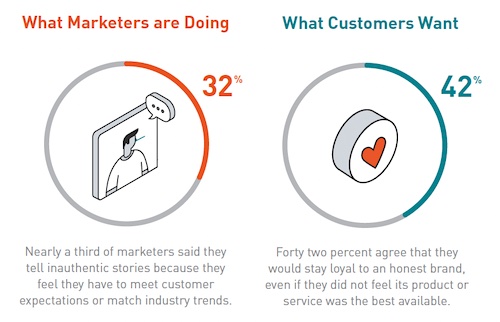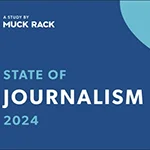 |
"Marketers are lying and customers can tell.” So says a new study from PAN Communications about the gap between the strategies marketers use to tell brand stores and the ways in which customers understand and relate to those stories.
“Missed Connections,” which surveyed 100 senior marketers and 1,000 consumers, found that a big part of the problem lies with marketers trying to tell consumers what they want to hear rather that what the reality of the brand story dictates.
Almost a third (32 percent) of the marketers surveyed said that they sometimes tell inauthentic stories “because they feel they have to meet customer expectations or match industry needs.”
In addition, seven in 10 (70 percent) say they face pressure to tell inauthentic stores, with half (50 percent) saying they face “some pressure,” 15 percent facing “frequent pressure” and five percent facing “constant pressure” to do so.
 |
But the study maintains that authenticity is key to successful communications—and its’s something that can’t be faked or replaced.
One of the essential components of authenticity, consumers say, is a sense of shared values with a brand. Almost three quarters (71 percent) of consumers said that the values of individual executives have a direct impact on a brand’s reputation. Over half (55 percent) said they are more likely to recommend a brand to others if it reflects their values.
That’s especially important given the weight that personal recommendations have for many consumers. Almost a third (31 percent) of those surveyed said that rely on people they know, rather than brand messaging, to get information about new brands.
Even when marketers have an authentic, interesting story to tell, the study results indicated that they have a tough time figuring out how to go about that. More than a quarter of respondents (28 percent) said their storytelling is kept from succeeding by “inefficient methods of distribution.”
The study concludes that marketers need to learn more about their audience, and one way to do that is to “start thinking about who tells their brand story and how it is communicated.”
By bringing a range of voices—employees, customers and even other industry leaders—into the mix, the study’s authors say that “you start to build a community rather than just a narrative.”
PAN’s study was conducted between September 29 and October 27 of this year.


 Consumers who once demanded convenience now require consistent, multi-channel experiences that cater to them at every point. Brands must have a clear, audience-appropriate, and channel-specific voice across all platforms.
Consumers who once demanded convenience now require consistent, multi-channel experiences that cater to them at every point. Brands must have a clear, audience-appropriate, and channel-specific voice across all platforms. Employees at U.S. companies are experiencing high levels of burnout, but managers are lagging behind when it comes to their awareness of the problem
Employees at U.S. companies are experiencing high levels of burnout, but managers are lagging behind when it comes to their awareness of the problem Brand has a powerful effect on a company’s valuation, but the level of brand understanding in the investment community leaves a lot to be desired, according to a new study from Brodeur Partners, Interbrand and NewtonX.
Brand has a powerful effect on a company’s valuation, but the level of brand understanding in the investment community leaves a lot to be desired, according to a new study from Brodeur Partners, Interbrand and NewtonX. AI may still be viewed with a wary eye by most media pros, but its use is growing, according to a new study from Muck Rack.
AI may still be viewed with a wary eye by most media pros, but its use is growing, according to a new study from Muck Rack. A new study from Walker Sands says that some marketers have been putting the cart before the horse when it comes to the relationship between marketing channels and business outcomes.
A new study from Walker Sands says that some marketers have been putting the cart before the horse when it comes to the relationship between marketing channels and business outcomes.


 Have a comment? Send it to
Have a comment? Send it to 
Nov. 22, 2022, by Bill Huey
"Even when marketers have an authentic, interesting story to tell, the study results indicated that they have a tough time figuring out how to go about that."
Poor marketers. The came up in a world where marketing is frequently confused with sales, and promotion is confused with both. They simply can't tell it straight without overselling. I recall writing some just-the-facts copy for a B2B client and being told, "it just doesn't sell enough." It wasn't long before the relationship ended.
It is our job to help marketers, because storytelling is what we do best.